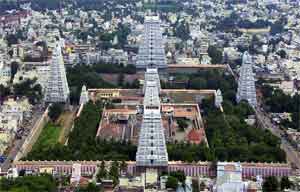
History of Thiruvannamalai
The temple town of Tiruvannamalai is one of the most ancient heritage sites of India and is a center of the Saiva religion. The Arunachala hill and its environs have been held in great regard by the Tamils for centuries. The temple is grand in conception and architecture and is rich in tradition, history and festivals.
In ancient times, the term "Annamalai" meant an inaccessible mountain. The word "Thiru" was prefixed to signify its greatness, and coupled with the two terms, it is called Tiruvannamalai.
The history of this town dates from the early Chola period i.e. the period of Aditya I and Parantaka I (A.D. 871-955) when the Chola empire had expanded northwards to include practically the whole of Tondaimandalam. After Parantaka I till the reign of Rajendra I, Chola rule over this region is not attested by the Tiruvannamalai inscriptions, possibly on account of the Rashtrakuta invasions and occupation of this area by Krishna III. This is perhaps indicated by a single inscription of Kannaradeva (Krishna III) found in this temple. (475;63). the recovery of this region by the Cholas was a slow process and reached its successful conclusion only towards the close of Rajaraja I's reign i.e. AD 1014, for even Rajaraja is conspicuously absent in the inscriptions of Tiruvannamalai.
While the rule of Rajendra I and Rajadhiraja I over this area is attested by their inscriptions, once again a fairly long gap of over a hundred years is indicated by the absence of any Chola inscriptions till the beginning of Kulottunga III's reign (AD 1183)
Large scales activities in the period of Kulottunga III and Rajaraja III are indicated by a number of records in the temple. Further, the frequent references to a number of Chola feudatories of this period would also show a gradual ascendancy in their power and importance till the final establishment of independence by the Kadavaraya chieftains in the second quarter of the 13th century A.D. In this connection mention may be made of an interesting inscription at Tiruvannamalai, which records the agreement entered into by a number of feudatory chieftains to support one another and swearing allegiance to the ruling Chola king (Kulottunga III-A.D. 1210), pointing to a period of great political tension under the late Cholas (516;106).
The inscriptions of Kopperunjinga clearly show that by the second quarter of the 13th century, the Kadavarayas had established complete mastery over this region leading to the final decline of Chola power.
A brief period of Pandya supremacy over this region is indicated by the inscriptions of the Pandyas of the second empire such as Jatavaraman Srivallabha and Tribhuvanachakravartin Kulasekhara in the 13th century AD (481,571 etc; 70,162 ect,).
The Hoysalas under Vira Vallaladeva (Ballala III) also exercised sway over this area (459, 509; 89 and 99 - dated AD 1340) indication that the Hoysala power continued to influence Tamil politics even after the Muslim invasions of Malik Kafur.
After the Hoysalas, Tiruvannamalai passed into the hands of the Vijayanagar rulers, whose southern invasions under Kampana are well known and led to the establishment of Vijayanagar authority over practically the whole of Tamil Nadu.
Vijayanagar inscriptions in this temple are fairly large in number and range from the period of Harihara II to the late Vijayanagar ruler Venkatapatideva Maharaya i.e. late 14th to the 17th centuries AD.Following them, their Kayak feudatories of Tanner, established their independent sway over this region and under the famous Sevvappa Nayaka, carried out large scale renovation and building activities in the temple.
Mr. Dupleix succeeded Dumas as Governor of Pondicherry. Then, in 1748, British reinforcements, intended for the recovery of Madras, arrived with a new fleet under Boscawin. Pondicherry in its turn was besieged, but once more French enterprise was aided by British ineptitude in securing a French success. Due to the war between Dupleix and La Bourdannais in 1748, Madras was restored to the English and maintained the status quo. But the restoration revealed a profound change in the politics of South India. Three taluks adjoining Pondicherry viz., Valudavur, Villianur and Bahur were handed over to Dupleix as reward for his kind assistance, during the Ambur battle in 1749.
Mr. Dupleix refused to admit defeat and with infinite resource continued the struggle. He even besieged Trichinopoly a second time in 1753. The triumph of Arcot was followed by more victories at Arni, Kaveripakkam and Valikandapuram over the forces of Chanda Sahib and the French. So the campaigns continued throughout the year 1753. But early in 1754, Dupleix was forced to open negotiations with the British. Meanwhile the French company had decided upon his recall. Due to the hostilities between the English and the French in 1756, neither Madras nor Pondy was properly garrisoned.
D' Auteuil, one of the officers of Dupleix - Govenor of Pondicherry - captured Elavanasur. The French then took Tiruvannamalai and other forts, threatened Thyaga Drug, attacked Fort David, inspite of the fact that their fleet was defeated by the English fleet in an action off Nagapattinam.
After Nayak rule, this region seems to have gradually passed into British hands except for a brief period of subordination to the Mysore Odeyars (AD 1816).